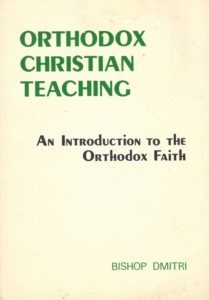Dmitri Outlines Orthodox Faith

Bishop Dmitri. 1980. Orthodox Christian Teaching: An Introduction to the Orthodox Faith. Syosset, New York: Orthodox Church in America.
Review by Stephen W. Hiemstra
Since the Great Schism of 1054, which divided the Catholic Church and the Eastern Orthodox Church, the Orthodox Church has been viewed as mysterious in the West. Efforts by Pope Paul VI to patch up differences between East and West since 1965 have only been partially successful. For Protestants that generally keep an arms-length distance with Catholics, the smells and bells of the Orthodox Church are even more of a curiosity. Personally, in addressing a Mosque in Chantilly a few years back, I took the view that anyone who takes God seriously in this secular age must be considered a brother or sister in faith.
IntroductionIn the preface to his book, Orthodox Christian Teaching: An Introduction to the Orthodox Faith Bishop Dmitri writes: “This book is intended to be used by adults as an introduction to the teachings of the Orthodox Church.” (4). The Orthodox Church claims to be founded on the faith of the Apostle, as presented in scripture and the traditions of the church (4-7), and Apostolic succession, the laying on of hands upon hands going back to the Apostolic era.
Background and OrganizationArchbishop Dmitri (1923-2011) was born Robert Roscoe Royster and raised as a Southern Baptist. He converted to orthodoxy in 1939. He joined the Army in 1943 and served on the staff of General MacArthur as a Japanese translator. He later finished his studies at North Texas State University and earned a Masters in Spanish. He wrote numerous publications and books about Orthodoxy.
Dmitri writes in fifteen chapters:
Sources of Orthodox Christian TeachingThe Doctrine of God: God’s Revelation to ManThe Doctrine of GodThe Incarnation and the Mission of the ChristThe ChurchThe Holy Mysteries of BaptismThe Holy Mysteries: Chrismation and CommunionThe Sacraments of Healing: Confession and UnctionOrdination and MatrimonyThe Divine Liturgy: The Liturgy and the CatechumensThe Divine Liturgy: The EucharistThe Veneration of the Virgin Mary in the Orthodox ChurchOn Prayer and FastingOrthodoxy Throughout the WorldThe Last Things: Eschatology (3).These chapters are introduced with a preface and followed by a word list and suggested readings.
Sources of AuthorityOne of the central tenants of the Protestant reformation was captured in the phrase, solo scriptura, which means by scripture alone. Scripture, it was confessed, was the sole, written authority for the church. Other things, such as tradition, culture, and psychology, were not believed to inspire our faith (Sproul 1997, 41-44). Most denominations remain orthodox in their formal theology, but they generally soft-pedal theology and their orthopraxis no longer treats scripture as their sole authority.
Dmitri writes:
“When one studies the Orthodox Church, he immediately sees that there are many things both in its teaching and practices that are not found in the New Testament scriptures.” (6)
While giving priority to the Bible in its teaching and practice, the Orthodox Church also venerates oral and written tradition, the writings of seven councils of the church, and liturgical texts. However, these must be consistent with scripture (6-7).
Four Marks of the ChurchDmitri articulates a clean sense of the Orthodox Church’s ecclesiology, theology of the church. He writes: “The Church is identifiable by four marks that believers confess in the Nicene Creed: One, Holy, Catholic, and Apostolic.” (24)
Oneness implies unity. Dmitri cites Ephesians 4:4-6: One Lord, one faith, one baptism, and one God and Father of us all.
Holy emphasizes the need for continual sanctification.
Catholic implies full and complete.
Apostolic implies preservation of: “The Apostolic Church without break or change in doctrine and in apostolic succession.” (24)
AssessmentBishop Dmitri’s Orthodox Christian Teaching: An Introduction to the Orthodox Faith is a succinct and readable statement of the beliefs and practice of the Orthodox Church. I would commend it to anyone curious about the beliefs of this ancient church.
ReferencesSproul, R.C. 1997. What is Reformed Theology: Understanding the Basics. Grand Rapids: Baker Books.
Footnoteshttps://en.wikipedia.org/wiki/Dmitri_....
] https://en.wikipedia.org/wiki/East%E2...
Dmitri Outlines Orthodox FaithAlso see:Books, Films, and MinistryOther ways to engage online:Author site: http://www.StephenWHiemstra.netPublisher site: http://www.T2Pneuma.com Newsletter: https://bit.ly/Mem_2022, Signup
The post Dmitri Outlines Orthodox Faith appeared first on T2Pneuma.net.



